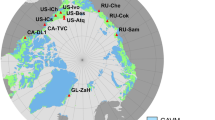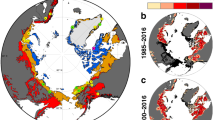Abstract
Arctic tundra currently stores half of the global soil carbon (C) stock1. Climate warming in the Arctic may lead to accelerated CO2 release through enhanced decomposition and turn Arctic ecosystems from a net C sink into a net C source, if warming enhances decomposition more than plant photosynthesis2. A large portion of the circumpolar Arctic is grazed by reindeer/caribou, and grazing causes important vegetation shifts in the long-term. Using a unique experimental set-up, where areas experiencing more than 50 years of either light (LG) or heavy (HG) grazing were warmed and/or fertilized, we show that under ambient conditions areas under LG were a 70% stronger C sink than HG areas. Although warming decreased the C sink by 38% under LG, it had no effect under HG. Grazing history will thus be an important determinant in the response of ecosystem C balance to climate warming, which at present is not taken into account in climate change models.
This is a preview of subscription content, access via your institution
Access options
Subscribe to this journal
Receive 12 print issues and online access
$209.00 per year
only $17.42 per issue
Buy this article
- Purchase on Springer Link
- Instant access to full article PDF
Prices may be subject to local taxes which are calculated during checkout




Similar content being viewed by others
References
Tarnocai, C. et al. Soil organic carbon pools in the northern circumpolar permafrost region. Glob. Biogeochem. Cycle 23, GB2023 (2009).
Davidson, E. A. & Janssens, I. A. Temperature sensitivity of soil carbon decomposition and feedbacks to climate change. Nature 440, 165–173 (2006).
Forbes, B. C. & Kumpula, T. The ecological role and geography of reindeer (Rangifer tarandus) in northern Eurasia. Geogr. Compass 3, 1356–1380 (2009).
Stark, S., Strömmer, R. & Tuomi, J. Reindeer grazing and soil microbial processes in two suboceanic and two subcontinental tundra heaths. Oikos 97, 69–78 (2002).
Olofsson, J., Stark, S. & Oksanen, L. Reindeer influence on ecosystem processes in the tundra. Oikos 105, 386–396 (2004).
Post, E. & Pedersen, C. Opposing plant community responses to warming with and without herbivores. Proc. Natl Acad. Sci. USA 105, 12353–12358 (2008).
Olofsson, J. et al. Herbivores inhibit climate-driven shrub expansion on the tundra. Glob. Change Biol. 15, 2681–2693 (2009).
Cahoon, S. M., Sullivan, P. F., Post, E. & Welker, J. M. Large herbivores limit CO2 uptake and suppress carbon cycle responses to warming in West Greenland. Glob. Change Biol. 18, 469–479 (2012).
Olofsson, J. Short-and long-term effects of changes in reindeer grazing pressure on tundra heath vegetation. J. Ecol. 94, 431–440 (2006).
Myers-Smith, I.H. et al. Shrub expansion in tundra ecosystems: Dynamics, impacts and research priorities. Environ. Res. Lett. 6, 045509 (2011).
Hobbie, S. E. Temperature and plant species control over litter decomposition in Alaskan tundra. Ecol. Monogr. 66, 503–522 (1996).
Cahoon, S. M., Sullivan, P. F., Shaver, G. R., Welker, J. M. & Post, E. Interactions among shrub cover and the soil microclimate may determine future Arctic carbon budgets. Ecol. Lett. 15, 1415–1422 (2012).
Euskirchen, E., Bret-Harte, M. S., Scott, G. J., Edgar, C. & Shaver, G. R. Seasonal patterns of carbon dioxide and water fluxes in three representative tundra ecosystems in northern Alaska. Ecosphere 3, 1–19 (2012).
Sjögersten, S., van der Wal, R., Loonen, M. J. J. E. & Woodin, S. J. Recovery of ecosystem carbon fluxes and storage from herbivory. Biogeochemistry 106, 357–370 (2011).
Olofsson, J. & Oksanen, L. Role of litter decomposition for the increased primary production in areas heavily grazed by reindeer: A litterbag experiment. Oikos 96, 507–515 (2002).
Olofsson, J., Kitti, H., Rautiainen, P., Stark, S. & Oksanen, L. Effects of summer grazing by reindeer on composition of vegetation, productivity and nitrogen cycling. Ecography 24, 13–24 (2001).
Volk, M. et al. Subalpine grassland carbon dioxide fluxes indicate substantial carbon losses under increased nitrogen deposition, but not at elevated ozone concentration. Glob. Change Biol. 17, 366–376 (2011).
Christiansen, C. T., Svendsen, S. H., Schmidt, N. M. & Michelsen, A. High Arctic heath soil respiration and biogeochemical dynamics during summer and autumn freeze-in-effects of long-term enhanced water and nutrient supply. Glob. Change Biol. 18, 3224–3236 (2012).
Hafner, S. et al. Effect of grazing on carbon stocks and assimilate partitioning in a Tibetan montane pasture revealed by 13CO2 pulse labeling. Glob. Change Biol. 18, 528–538 (2012).
Eskelinen, A. Herbivore and neighbour effects on tundra plants depend on species identity, nutrient availability and local environmental conditions. J. Ecol. 96, 155–165 (2008).
Post, E. S. & Klein, D. R. Relationships between graminoid growth form and levels of grazing by caribou (Rangifer tarandus) in Alaska. Oecologia 107, 364–372 (1996).
Ravolainen, V. T. et al. Rapid, landscape scale responses in riparian tundra vegetation to exclusion of small and large mammalian herbivores. Basic Appl. Ecol. 12, 643–653 (2011).
Tommervik, H., Dunfjeld, S., Olsson, G. A. & Ostby Nilsen, M. Detection of ancient reindeer pens, cultural remains and anthropogenic influenced vegetation in Byrkije (Borgefjell) mountains, Fennoscandia. Landscape Urban Plan. 98, 56–71 (2010).
Josefsson, T., Hörnberg, G. & Östlund, L. Long-term human impact and vegetation changes in a boreal forest reserve: Implications for the use of protected areas as ecological references. Ecosystems 12, 1017–1036 (2009).
Räsänen, S., Froyd, C. & Goslar, T. The impact of tourism and reindeer herding on forest vegetation at Saariselkä, Finnish Lapland: A pollen analytical study of a high-resolution peat profile. Holocene 17, 447–456 (2007).
Zamin, T. J. & Grogan, P. Caribou exclusion during a population low increases deciduous and evergreen shrub species biomass and nitrogen pools in low Arctic tundra. J. Ecol. 101, 671–683 (2013).
Elmendorf, S., Henry, G. H. R., Hollister, R. D. & Björk, R. G. Global assessment of experimental climate warming on tundra vegetation: Heterogeneity over space and time. Ecol. Lett. 15, 164–175 (2012).
Bokhorst, S. et al. Microclimate impacts of passive warming methods in Antarctica: Implications for climate change studies. Polar Biol. 34, 1421–1435 (2011).
Phoenix, G. K. et al. Impacts of atmospheric nitrogen deposition: Responses of multiple plant and soil parameters across contrasting ecosystems in long-term field experiments. Glob. Change Biol. 18, 1197–1215 (2012).
Mack, M. C., Schuur, E. A. G., Bret-Harte, M. S., Shaver, G. R. & Chapin, F. S. Ecosystem carbon storage in Arctic tundra reduced by long-term nutrient fertilization. Nature 43, 440–443 (2004).
Acknowledgements
We thank A. Niva and S. Aakkonen for their valuable help with the field experiments. We thank Su. Katves and Si. Katves for assisting with vegetation recording and J. Hyvönen for helping with the statistical analysis. This study was funded by the Academy of Finland (project numbers 218121 and 130507).
Author information
Authors and Affiliations
Contributions
S.St. and M.V. initiated and managed the field experiment. J.O. and S.Sj contributed to the planning of the experiment. M.V. and H.Y. carried out C flux measurements with contributions from S.St. and S.Sj. E.K. and J.O. were responsible for plant and NDVI analyses. N.C. was responsible for modelling C fluxes. M.V. carried out the statistical analyses. M.V. and S.St. wrote the manuscript, to which all other authors contributed with discussions and text.
Corresponding author
Ethics declarations
Competing interests
The authors declare no competing financial interests.
Supplementary information
Rights and permissions
About this article
Cite this article
Väisänen, M., Ylänne, H., Kaarlejärvi, E. et al. Consequences of warming on tundra carbon balance determined by reindeer grazing history. Nature Clim Change 4, 384–388 (2014). https://doi.org/10.1038/nclimate2147
Received:
Accepted:
Published:
Issue Date:
DOI: https://doi.org/10.1038/nclimate2147
This article is cited by
-
Wilder rangelands as a natural climate opportunity: Linking climate action to biodiversity conservation and social transformation
Ambio (2024)
-
Herbivory and nutrients shape grassland soil seed banks
Nature Communications (2023)
-
Mapping cumulative pressures on the grazing lands of northern Fennoscandia
Scientific Reports (2022)
-
Distinguishing Rapid and Slow C Cycling Feedbacks to Grazing in Sub-arctic Tundra
Ecosystems (2019)
-
Experimental herbivore exclusion, shrub introduction, and carbon sequestration in alpine plant communities
BMC Ecology (2018)



